Growth, Stratification, and Liberation of Phosphorus-Rich C2S in Modified BOF Steel Slag
Abstract
1. Introduction
2. Experimental
2.1. Modification of Original BOF Slag
2.2. Kilo-Scale Modification of the BOF Slag
2.3. Liberation of P-Rich C2S in the Upper and Lower Modified Slags
2.4. Characterization
3. Results and Discussion
3.1. Crystal Growth of P-Rich C2S in the Modified Slag
3.2. Stratification of P-Rich C2S in the Modified Slag
3.3. Liberation Degree of P-Rich C2S in the Modified Slag
4. Conclusions
Author Contributions
Funding
Acknowledgments
Conflicts of Interest
References
- Wang, Q.; Yan, P.Y. Hydration properties of basic oxygen furnace steel slag. Constr. Build. Mater. 2010, 24, 1134–1140. [Google Scholar] [CrossRef]
- Wu, Z.J.; Yue, H.F.; Li, L.S.; Jing, B.F.; Wu, X.R.; Wang, P. Synthesis and electrochemical properties of multi-doped LiFePO4/C prepared from the steel slag. J. Power Sour. 2010, 195, 2888–2893. [Google Scholar] [CrossRef]
- Wu, Z.J.; Jiang, B.F.; Liu, W.M.; Cao, F.B. Selective recovery of valuable components from converter steel slag for preparing multidoped FePO4. Ind. Eng. Chem. 2011, 50, 13778–13788. [Google Scholar] [CrossRef]
- Semykina, A.; Shatokha, V.; Seetharaman, S. Innovative approach to recovery of iron from steelmaking slags. Ironmak. Steelmak. 2010, 37, 536–540. [Google Scholar] [CrossRef]
- Semykina, A.; Seetharaman, S. Recovery of manganese ferrite in nanoform from the metallurgical slags. Metall. Mater. Trans. B 2011, 42, 2–4. [Google Scholar] [CrossRef]
- Kuwahara, Y.; Ohmichi, T.; Mori, K.; Katayama, I. Synthesis of zeolite from steel slag and its application as a support of nano-sized TiO2 photocatalyst. J. Mater. Sci. 2008, 43, 2407–2410. [Google Scholar] [CrossRef]
- Shen, H.; Forssberg, E. An overview of recovery of metals from slags. Waste Manag. 2003, 23, 933–949. [Google Scholar] [CrossRef]
- Iwasaki, I.; Fregeau-Wu, E.; Fujita, T. Removal of phosphorus from steelmaking slags: Aliterature survey. Miner. Process. Extr. Metall. Rev. 1993, 12, 19–36. [Google Scholar] [CrossRef]
- Alanyali, H.; Col, M.; Yilmaz, M.; Karagoz, S. Application of magnetic separation to steelmaking slags for reclamation. Waste Manag. 2006, 26, 1133–1139. [Google Scholar] [CrossRef]
- Ono, H.; Inagaki, A.; Masui, T.; Narita, H.; Mitsuo, T.; Nosaka, S.; Gohda, S. Removal of phosphorus from LD converter slag by floating of dicalcium silicate during solidification. Tetsu Hagane 1980, 66, 1317–1326. [Google Scholar] [CrossRef]
- Kubo, H.; Matsubae-Yokoyama, K.; Nagasaka, T. Magnetic separation of phosphorus enriched phase from multiphase dephosphorization slag. ISIJ Int. 2010, 50, 59–64. [Google Scholar] [CrossRef]
- Li, C.; Gao, J.; Guo, Z. Isothermal enrichment of P-concentrating phase from CaO-SiO2-FeO-MgO-P2O5 melt with super gravity. ISIJ Int. 2016, 56, 759–764. [Google Scholar] [CrossRef]
- Wang, N.; Liang, Z.G.; Chen, M.; Zou, Z.S. Phosphorous enrichment in molten adjusted converter slag: Part II. Enrichment behavior of phosphorus in CaO-SiO2-FeOx-P2O5molten slag. J. Iron Steel Res. Int. 2011, 18, 22–26. [Google Scholar] [CrossRef]
- Teratoko, T.; Maruoka, N.; Shibata, H.; Kitamura, S. Dissolution behavior of dicalcium silicate and tricalcium phosphate solid solution and other phases of steelmaking slag in an aqueous solution. High Temp. Mater. Process. 2012, 31, 329–338. [Google Scholar] [CrossRef]
- Numata, M.; Maruoka, N.; Kim, S.J.; Kitamura, S. Fundamental experiment to extract phosphorous selectively from steelmaking slag by leaching. ISIJ Int. 2014, 54, 1983–1990. [Google Scholar] [CrossRef]
- Du, C.; Gao, X.; Ueda, S.; Kitamura, S. Effects of cooling rate and acid on extracting soluble phosphorus from slag with high P2O5 content by selective leaching. ISIJ Int. 2017, 57, 487–496. [Google Scholar] [CrossRef]
- Du, C.; Gao, X.; Ueda, S.; Kitamura, S. Effect of Na2O addition on phosphorus dissolution from steelmaking slag with high P2O5 content. J. Sustain. Metall. 2017, 3, 671–682. [Google Scholar] [CrossRef]
- Du, C.; Gao, X.; Ueda, S.; Kitamura, S. Optimum conditions for phosphorus recovery from steelmaking slag with high P2O5 content by selective leaching. ISIJ Int. 2018, 58, 860–868. [Google Scholar] [CrossRef]
- Du, C.; Gao, X.; Ueda, S.; Kitamura, S. Recovery of phosphorus from modified steelmaking slag with high P2O5 content via leaching and precipitation. ISIJ Int. 2018, 58, 833–841. [Google Scholar] [CrossRef]
- Du, C.; Gao, X.; Ueda, S.; Kitamura, S. Effect of Fe2+/T.Fe ratio on the dissolution behavior of P from steelmaking slag with high P2O5 content. J. Sustain. Metall. 2018, 4, 443–454. [Google Scholar] [CrossRef]
- Du, C.; Gao, X.; Ueda, S.; Kitamura, S. Separation and recovery of phosphorus from steelmaking slag via a selective leaching–chemical precipitation process. Hydrometallurgy 2019, 189. [Google Scholar] [CrossRef]
- Duee, C.; Bourgel, C.; Veron, E.; Allix, M.; Fayon, F.; Bodenan, F.; Poirier, J. Phosphorus speciation in dicalcium silicate phases: Application to the basic oxygen furnace (BOF) slag. Cem. Concr. Res. 2015, 73, 207–214. [Google Scholar] [CrossRef]
- Wu, X.R.; Wang, P.; Li, L.S.; Wu, Z.J.; Chen, R.H. Distribution and enrichment of phosphorus in solidified BOF steelmaking slag. Ironmak. Steelmak. 2011, 38, 185–188. [Google Scholar] [CrossRef]
- Yang, G.M.; Wu, X.R.; Li, L.S.; Wu, Z.J.; Cao, F.B. Growth of phosphorus concentrating phase in modified steelmaking slags. Can. Metall. Quart. 2012, 51, 150–156. [Google Scholar] [CrossRef]
- Wu, X.R.; Yang, G.M.; Li, L.S.; Lv, H.H.; Wu, Z.J.; Shen, X.M. Wet magnetic separation of phosphorus containing phase from modified BOF slag. Ironmak. Steelmak. 2014, 41, 335–341. [Google Scholar] [CrossRef]
- Engtrom, F.; Adolfsson, D.; Yang, Q.; Samuelsson, C.; Bjorkman, B. Crystallization behaviour of some steelmaking slag. Steel Res. Int. 2010, 81, 362–371. [Google Scholar] [CrossRef]
- Gautier, M.; Poirier, J.; Bodenan, F.; Franceschini, G.; Veron, E. Basic oxygen furnace (BOF) slag cooling: Laboratory characteristics and prediction calculations. Int. J. Miner. Process. 2013, 123, 94–101. [Google Scholar] [CrossRef]
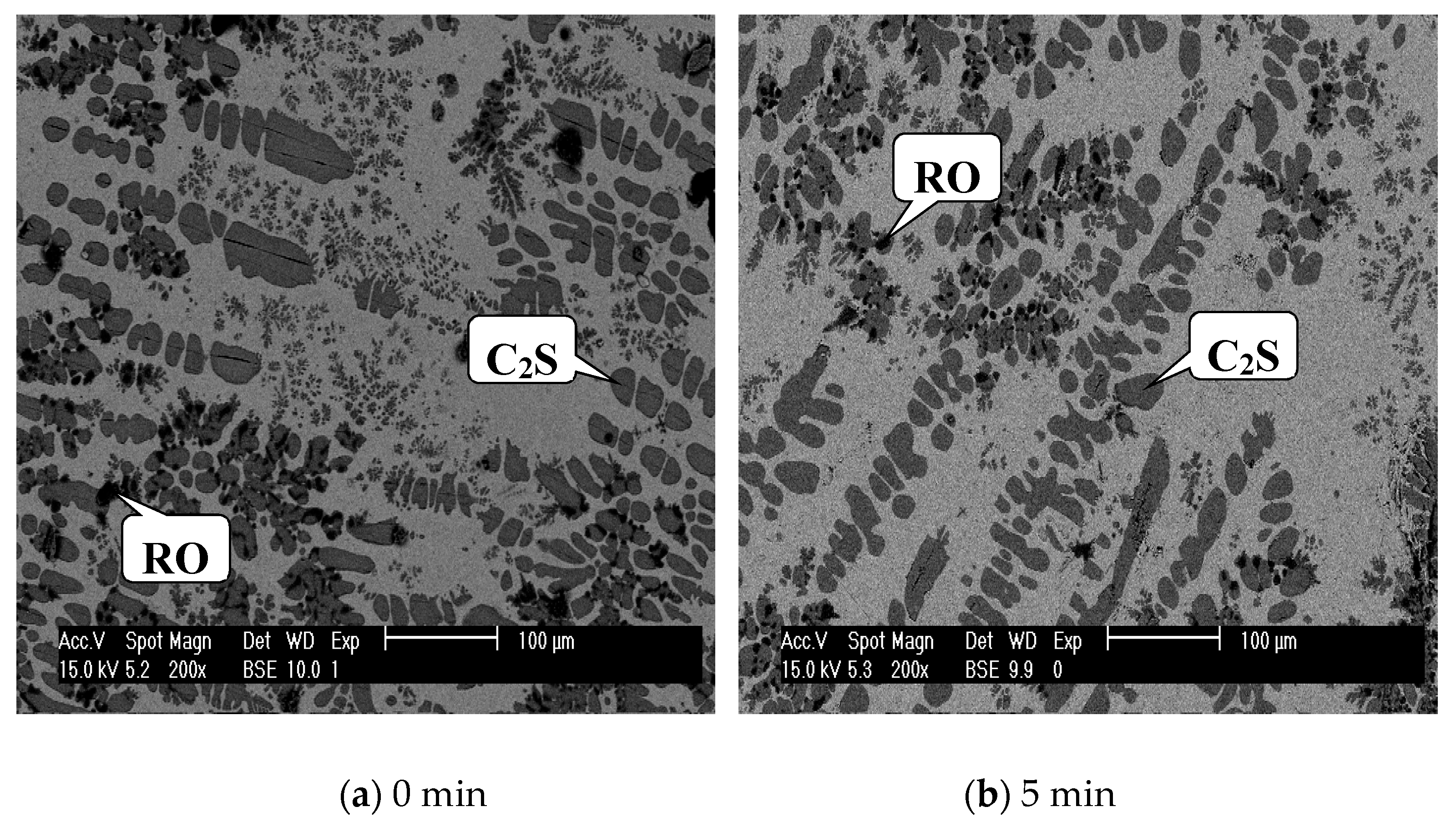

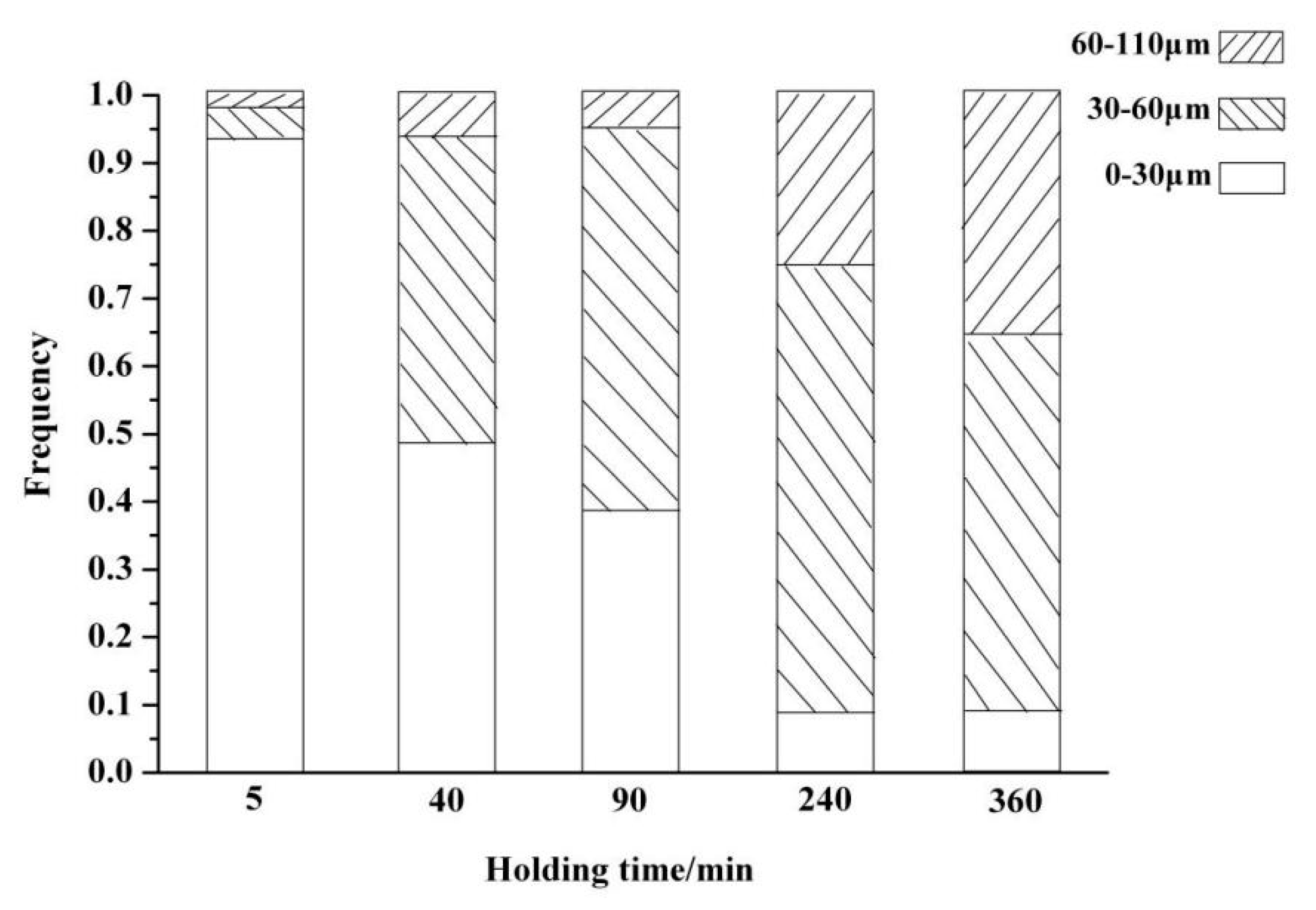
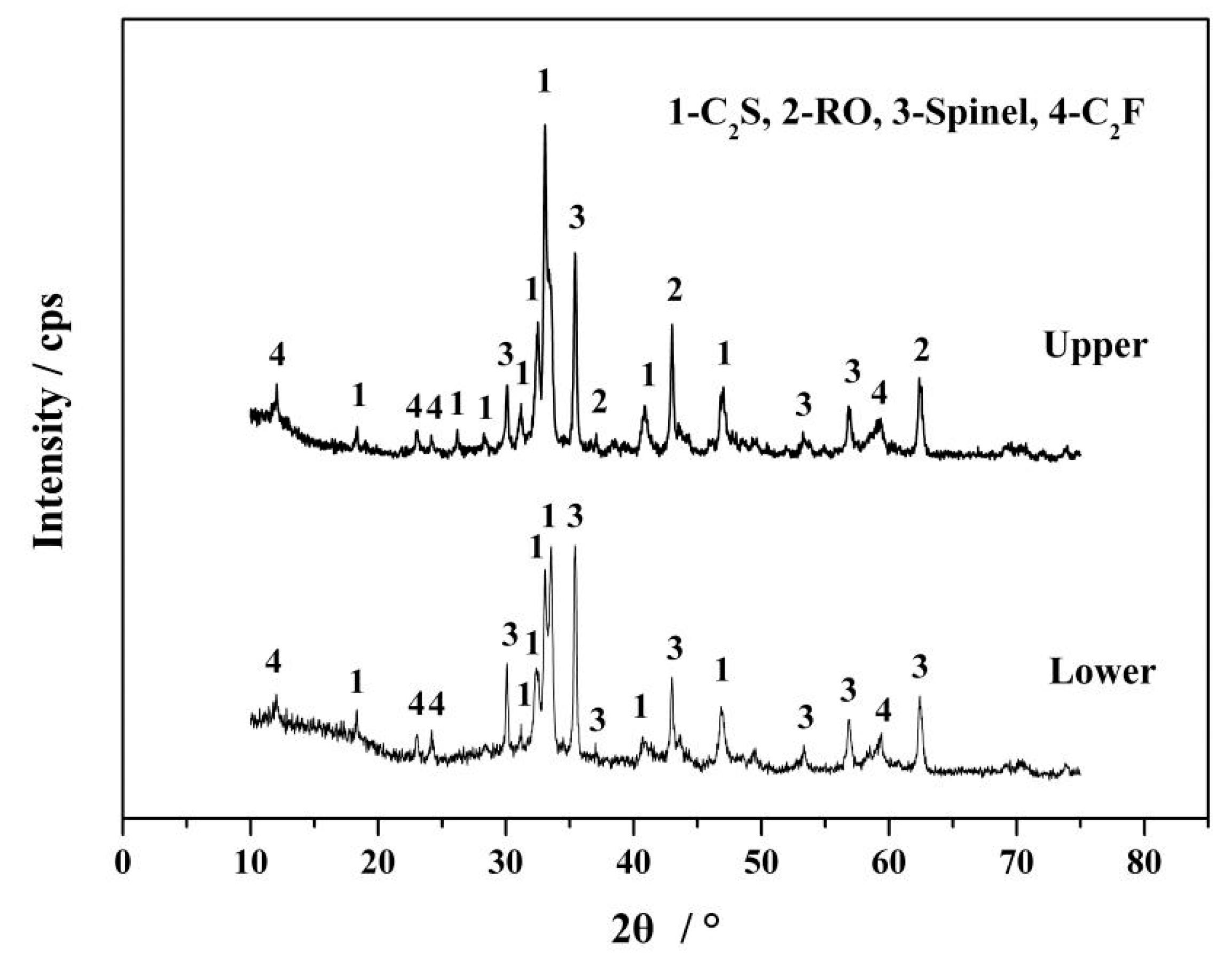
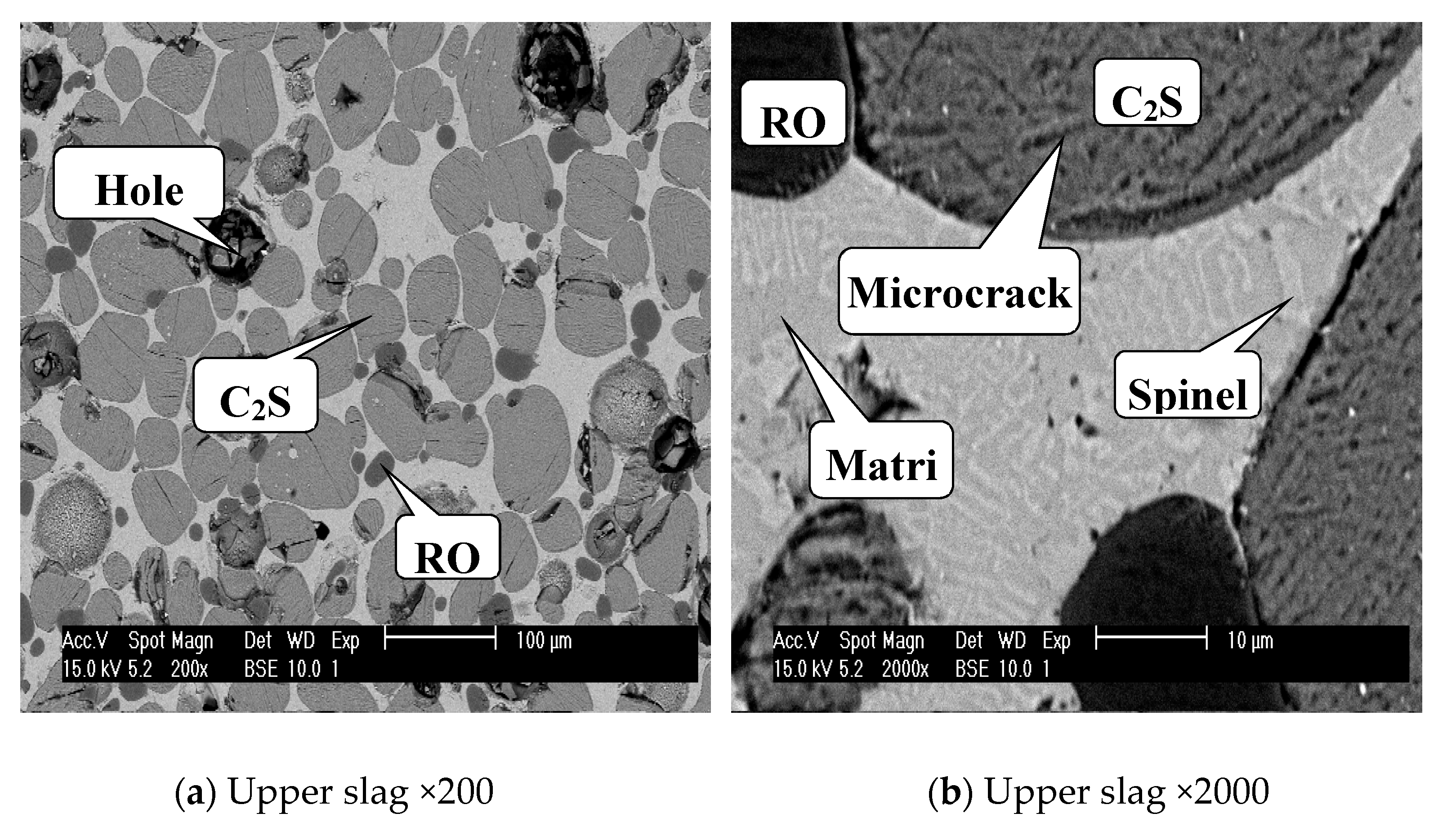
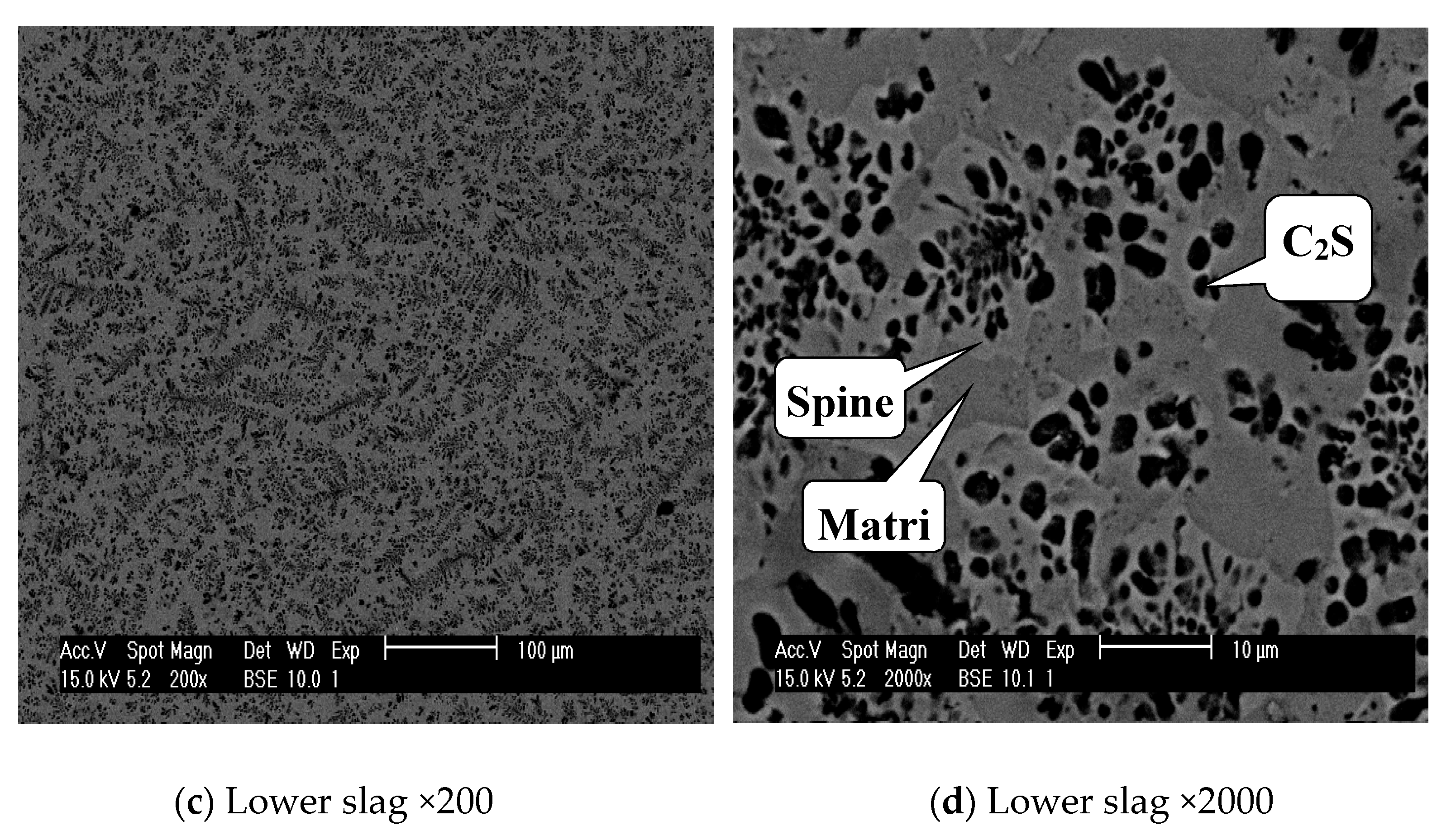
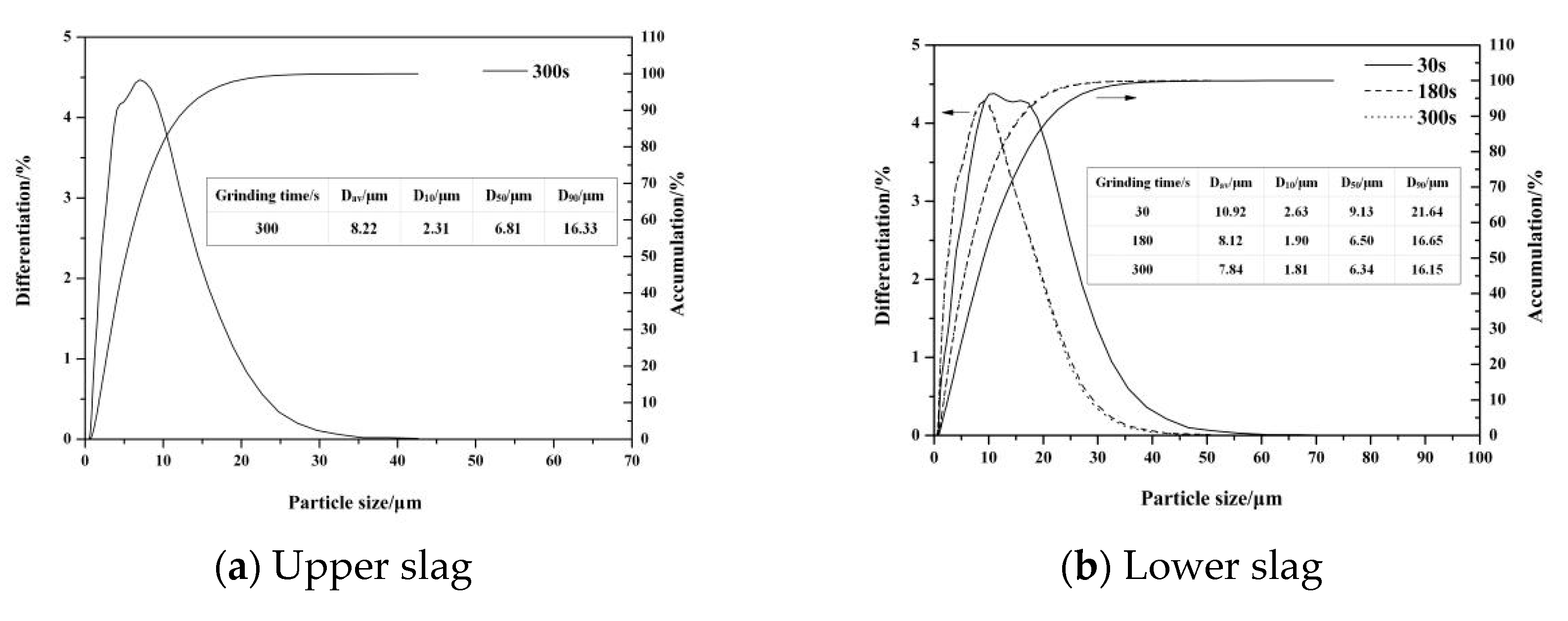
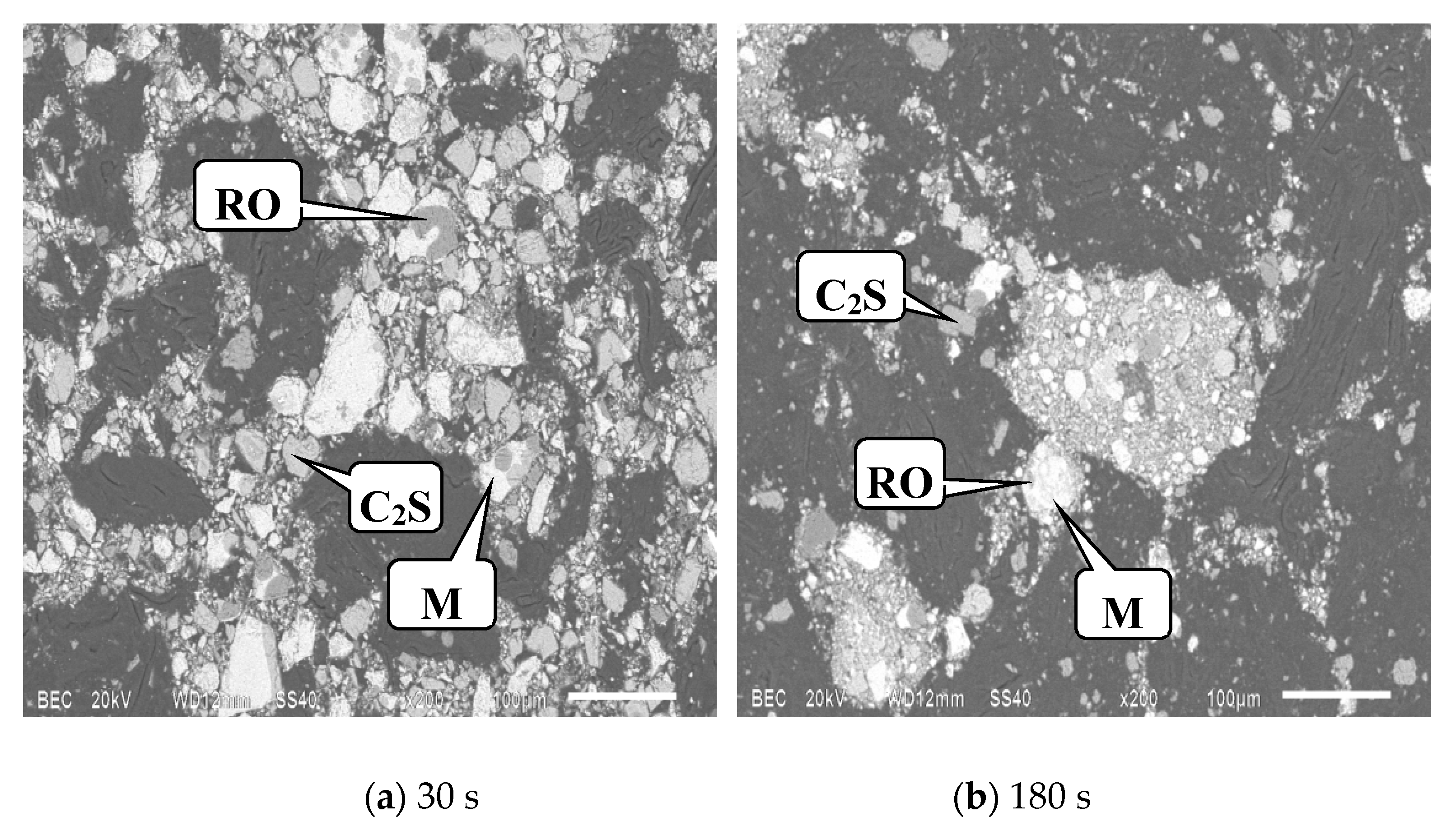
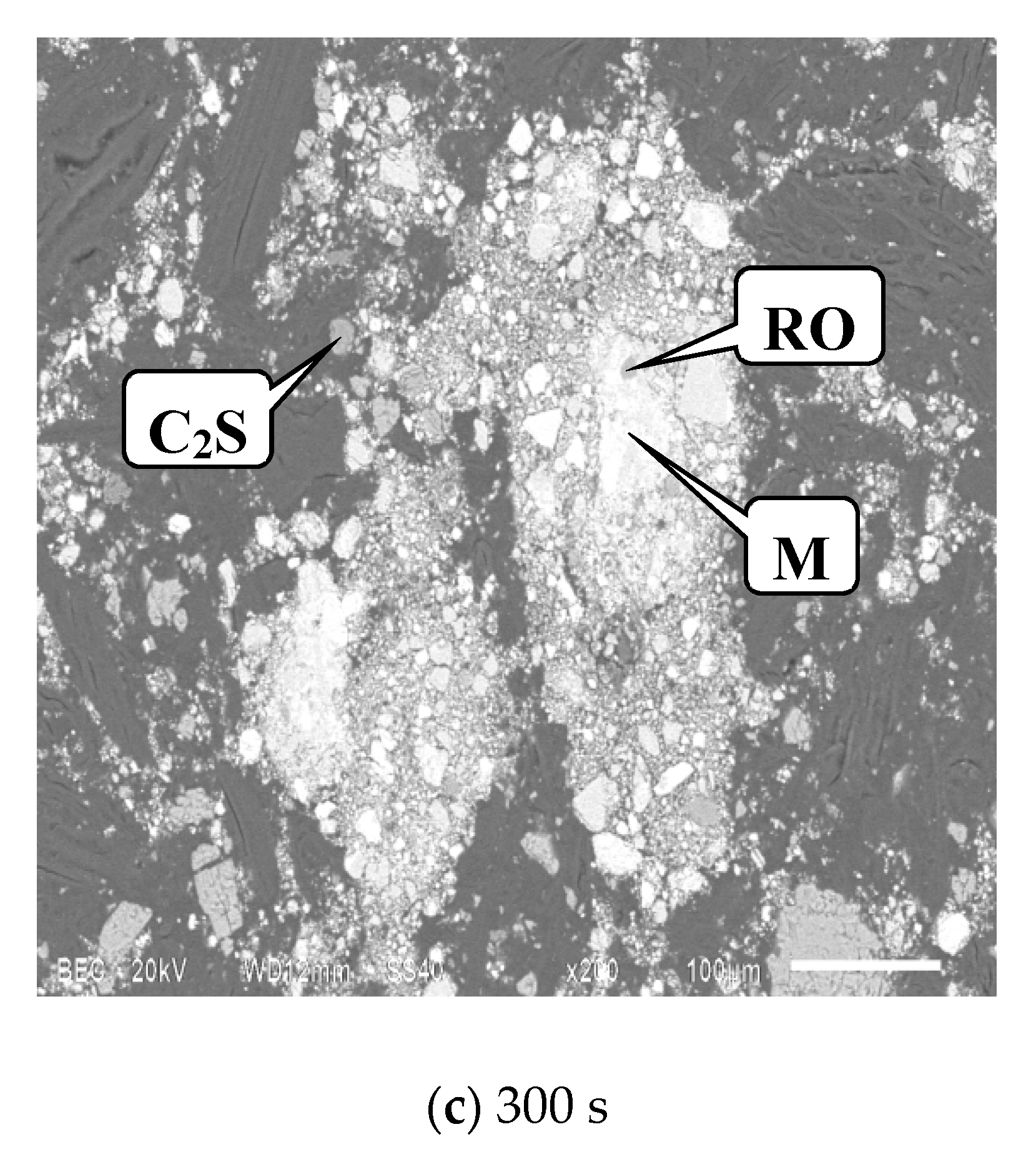

| Sample | CaO | SiO2 | P2O5 | MgO | MnO | Al2O3 | TiO2 | FeO | T.Fe |
|---|---|---|---|---|---|---|---|---|---|
| Original slag | 43.42 | 11.06 | 2.23 | 8.82 | 1.65 | 1.58 | 0.59 | 15.27 | 21.98 |
| Holding Time/min | Phase | Ca | Si | Fe | Mg | Al | Mn | P | O |
|---|---|---|---|---|---|---|---|---|---|
| 0 | C2S | 31.70 | 16.99 | - | 1.09 | - | - | 2.73 | 47.49 |
| RO | - | - | 7.11 | 58.76 | - | - | - | 34.13 | |
| Matrix | 16.70 | 7.56 | 24.08 | 8.10 | 2.17 | 2.29 | - | 38.19 | |
| 5 | C2S | 39.86 | 17.08 | - | - | - | - | 2.78 | 40.29 |
| RO | - | - | 8.78 | 56.91 | - | - | - | 34.31 | |
| Matrix | 22.68 | 4.41 | 26.55 | 3.88 | 2.24 | 2.03 | - | 38.20 | |
| 40 | C2S | 38.68 | 16.01 | 1.03 | - | - | 2.94 | 41.33 | |
| RO | - | - | 8.15 | 56.60 | - | - | - | 35.24 | |
| Matrix | 22.88 | 4.98 | 26.6 | 4.17 | 2.29 | 2.18 | - | 36.90 | |
| 90 | C2S | 39.76 | 17.01 | - | 1.02 | - | - | 3.17 | 39.04 |
| RO | - | - | 7.80 | 57.13 | - | - | - | 35.08 | |
| Matrix | 24.25 | 5.06 | 26.39 | 4.28 | 2.16 | 1.92 | - | 35.95 | |
| 240 | C2S | 38.98 | 17.21 | 1.32 | - | - | 3.23 | 39.27 | |
| RO | - | - | 6.26 | 58.53 | - | - | - | 35.21 | |
| Matrix | 22.67 | 5.07 | 26.47 | 4.26 | 2.25 | 1.94 | - | 37.32 | |
| 360 | C2S | 39.88 | 16.73 | - | 1.02 | - | - | 3.52 | 38.85 |
| RO | - | - | 9.06 | 57.85 | - | - | - | 33.09 | |
| Matrix | 23.70 | 4.98 | 29.50 | 4.27 | 2.09 | 2.85 | - | 32.60 |
| Holding Time/min | 0 | 5 | 40 | 90 | 240 | 360 | Original Slag |
|---|---|---|---|---|---|---|---|
| P2O5 (C2S)/wt% | 5.69 | 5.71 | 6.18 | 6.41 | 6.56 | 7.08 | 2.23 |
| Slag | Phase | Ca | Si | Fe | Mg | Al | Mn | P | O |
|---|---|---|---|---|---|---|---|---|---|
| Upper | C2S | 36.59 | 17.10 | - | 0.86 | - | - | 3.08 | 42.37 |
| RO | - | - | 7.97 | 57.23 | - | - | - | 34.80 | |
| Spinel | 5.39 | 1.12 | 37.81 | 12.18 | 3.99 | 2.78 | - | 36.73 | |
| Matrix | 28.27 | 4.71 | 26.03 | 0.90 | 3.20 | 1.29 | - | 35.62 | |
| Lower | C2S | 25.30 | 12.10 | 9.81 | 3.73 | 1.35 | - | 1.48 | 46.24 |
| Spinel | 6.44 | 2.87 | 35.41 | 12.25 | 1.81 | 3.48 | - | 37.74 | |
| Matrix | 28.86 | 4.56 | 23.86 | 1.07 | 1.88 | 1.93 | - | 36.81 |
| Sample | Upper | Lower | Original Slag |
|---|---|---|---|
| P2O5 (C2S)/wt% | 6.60 | 3.80 | 2.23 |
| Modified Slag | Number of C2S Free Particles | Number of C2S Locked Particles | Number of Other Particles | Total Number of Observed Particles | Liberation Degree of C2S/% | ||||||
|---|---|---|---|---|---|---|---|---|---|---|---|
| 3/4 | 1/2 | 1/4 | 1/8 | 1/16 | <1/16 | ||||||
| Upper | 30 s | 150 | 23 | 8 | 8 | 7 | 4 | 0 | 143 | 343 | 86.02 |
| 180 s | 103 | 4 | 1 | 6 | 1 | 0 | 0 | 100 | 212 | 95.12 | |
| 300 s | 97 | 0 | 5 | 4 | 4 | 2 | 0 | 136 | 248 | 95.92 | |
| Lower | 300 s | 40 | 38 | 28 | 30 | 35 | 27 | 0 | 38 | 251 | 40.07 |
© 2020 by the authors. Licensee MDPI, Basel, Switzerland. This article is an open access article distributed under the terms and conditions of the Creative Commons Attribution (CC BY) license (http://creativecommons.org/licenses/by/4.0/).
Share and Cite
Rao, L.; Dong, Y.; Gui, M.; Zhang, Y.; Shen, X.; Wu, X.; Cao, F. Growth, Stratification, and Liberation of Phosphorus-Rich C2S in Modified BOF Steel Slag. Materials 2020, 13, 203. https://doi.org/10.3390/ma13010203
Rao L, Dong Y, Gui M, Zhang Y, Shen X, Wu X, Cao F. Growth, Stratification, and Liberation of Phosphorus-Rich C2S in Modified BOF Steel Slag. Materials. 2020; 13(1):203. https://doi.org/10.3390/ma13010203
Chicago/Turabian StyleRao, Lei, Yuanchi Dong, Mancheng Gui, Yaohui Zhang, Xingmei Shen, Xingrong Wu, and Fabin Cao. 2020. "Growth, Stratification, and Liberation of Phosphorus-Rich C2S in Modified BOF Steel Slag" Materials 13, no. 1: 203. https://doi.org/10.3390/ma13010203
APA StyleRao, L., Dong, Y., Gui, M., Zhang, Y., Shen, X., Wu, X., & Cao, F. (2020). Growth, Stratification, and Liberation of Phosphorus-Rich C2S in Modified BOF Steel Slag. Materials, 13(1), 203. https://doi.org/10.3390/ma13010203




